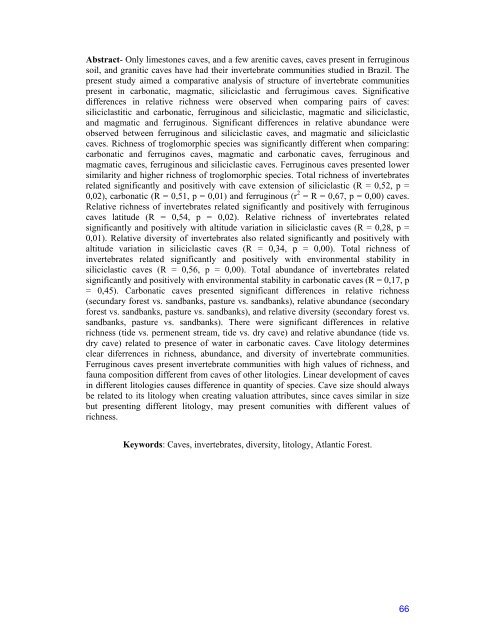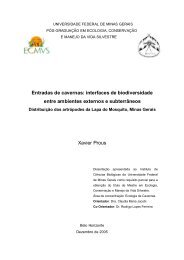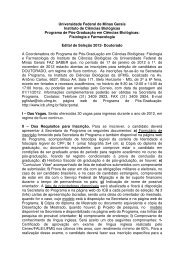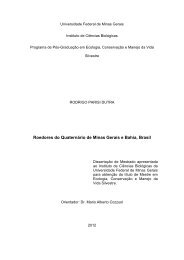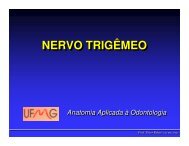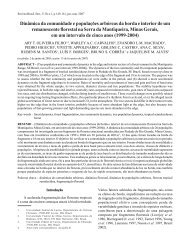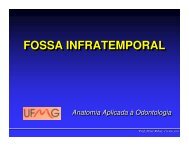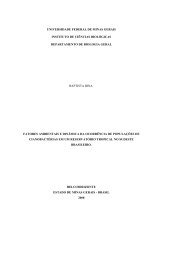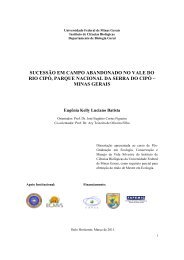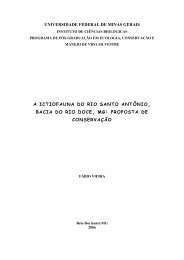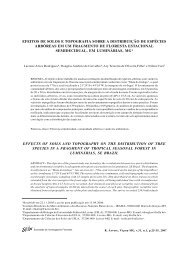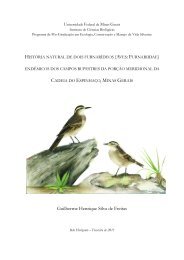ecologi ae conservação das comuni dades de i ... - ICB - UFMG
ecologi ae conservação das comuni dades de i ... - ICB - UFMG
ecologi ae conservação das comuni dades de i ... - ICB - UFMG
Create successful ePaper yourself
Turn your PDF publications into a flip-book with our unique Google optimized e-Paper software.
Abstract- Only limestones caves, and a few arenitic caves, caves present in ferruginoussoil, and granitic caves have had their invertebrate communities studied in Brazil. Thepresent study aimed a comparative analysis of structure of invertebrate communitiespresent in carbonatic, magmatic, siliciclastic and ferrugimous caves. Significativedifferences in relative richness were observed when comparing pairs of caves:siliciclastitic and carbonatic, ferruginous and siliciclastic, magmatic and siliciclastic,and magmatic and ferruginous. Significant differences in relative abundance wereobserved between ferruginous and siliciclastic caves, and magmatic and siliciclasticcaves. Richness of troglomorphic species was significantly different when comparing:carbonatic and ferruginos caves, magmatic and carbonatic caves, ferruginous andmagmatic caves, ferruginous and siliciclastic caves. Ferruginous caves presented lowersimilarity and higher richness of troglomorphic species. Total richness of invertebratesrelated significantly and positively with cave extension of siliciclastic (R = 0,52, p =0,02), carbonatic (R = 0,51, p = 0,01) and ferruginous (r 2 = R = 0,67, p = 0,00) caves.Relative richness of invertebrates related significantly and positively with ferruginouscaves latitu<strong>de</strong> (R = 0,54, p = 0,02). Relative richness of invertebrates relatedsignificantly and positively with altitu<strong>de</strong> variation in siliciclastic caves (R = 0,28, p =0,01). Relative diversity of invertebrates also related significantly and positively withaltitu<strong>de</strong> variation in siliciclastic caves (R = 0,34, p = 0,00). Total richness ofinvertebrates related significantly and positively with environmental stability insiliciclastic caves (R = 0,56, p = 0,00). Total abundance of invertebrates relatedsignificantly and positively with environmental stability in carbonatic caves (R = 0,17, p= 0,45). Carbonatic caves presented significant differences in relative richness(secundary forest vs. sandbanks, pasture vs. sandbanks), relative abundance (secondaryforest vs. sandbanks, pasture vs. sandbanks), and relative diversity (secondary forest vs.sandbanks, pasture vs. sandbanks). There were significant differences in relativerichness (ti<strong>de</strong> vs. permenent stream, ti<strong>de</strong> vs. dry cave) and relative abundance (ti<strong>de</strong> vs.dry cave) related to presence of water in carbonatic caves. Cave litology <strong>de</strong>terminesclear diferrences in richness, abundance, and diversity of invertebrate communities.Ferruginous caves present invertebrate communities with high values of richness, andfauna composition different from caves of other litologies. Linear <strong>de</strong>velopment of cavesin different litologies causes difference in quantity of species. Cave size should alwaysbe related to its litology when creating valuation attributes, since caves similar in sizebut presenting different litology, may present <strong>comuni</strong>ties with different values ofrichness.Keywords: Caves, invertebrates, diversity, litology, Atlantic Forest.66


